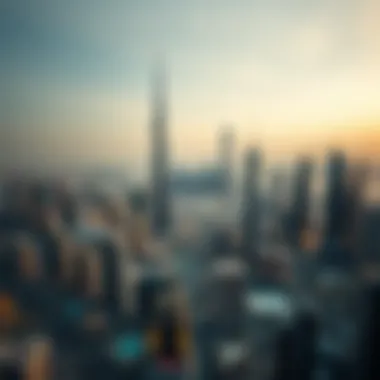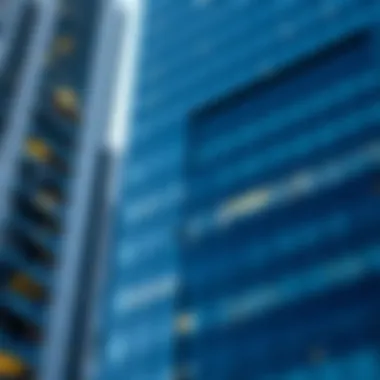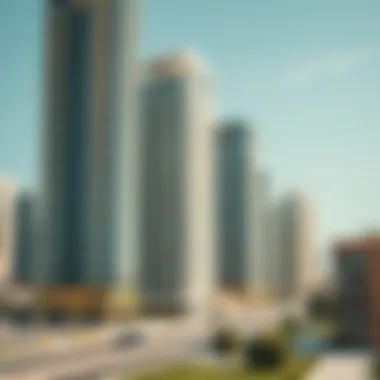Exploring Dubai's Iconic High-Rise Architecture


Intro
Dubai, a city that rises like a phoenix from the desert sands, has become synonymous with innovative architectural feats, particularly its high-rise buildings. These towering structures are not just about reaching for the sky; they symbolize the city’s ambition and economic prowess. From the iconic Burj Khalifa to the luxurious apartments of Marina Blue Tower, the high-rises of Dubai have transformed its skyline and turned it into a playground for architects, investors, and expatriates alike.
The dynamic real estate market in Dubai reflects a blend of modernity and traditional values. As more people flock to the Emirate to seek opportunities, the demand for residential and commercial space has surged. This article delves into the intricacies of Dubai's high-rises, dissecting their architectural value, economic implications, and what lies ahead for this glittering metropolis.
Join us as we navigate the swirling currents of Dubai's architecture and investment opportunities, ensuring that you, whether a homebuyer, savvy investor, real estate agent, developer, or expatriate, will walk away with a sharpened insight into how these skyscrapers shape the city's future and your potential success within it.
Prolusion to Dubai's High-Rise Landscape
Dubai's high-rise buildings stand as a testament to human ambition and ingenuity. Their soaring heights and innovative designs don’t just redefine the skyline; they encapsulate the spirit of a city that has rapidly evolved from a quiet trading hub to a global center of commerce, tourism, and architecture. In this section, we will delve deep into the historical context of Dubai’s skyscrapers and the dynamics that fueled their ascent.
Historical Context
The story of Dubai’s high-rise buildings is intricately linked to its history. In the mid-20th century, the discovery of oil transformed the region, stimulating both economic growth and a sudden influx of expatriates. With the newfound wealth, the ambition to create a modern, cosmopolitan city gained momentum. Initially, the architecture was modest, reflecting the city’s humble beginnings. However, by the late 1970s, efforts to modernize kicked into high gear, leading to the first wave of skyscrapers.
One notable example during this period is the Dubai World Trade Centre, completed in 1979. It became the first skyscraper in the city and symbolized the beginning of high-rise construction in the region. Over the next few decades, as economic diversification took place, the city embraced a more luxurious and innovative architectural approach, setting the stage for the iconic structures that now fill the skyline.
The Rise of Skyscrapers in Dubai
As we moved into the 21st century, Dubai’s architecture took aspirational leaps. The UAE's government outlined ambitious plans aimed at positioning Dubai as a global business hub. This was significantly supported by the Dubai 2020 Vision, which aimed to attract increased foreign investment and tourism. Consequently, the emergence of skyscrapers became not only a symbol of wealth but also a statement of Dubai's determination to stand amongst the world's top destinations.
The skyline became a canvas для architects who pushed architectural boundaries, resulting in buildings like the Burj Khalifa, completed in 2010, which claims the title of the tallest building in the world. The Burj reflects not just architectural excellence but also the blending of cultures and the infusion of modern technology in construction practices.
Furthermore, with advancements in technology and design philosophies, buildings now incorporate sustainable practices. Increasingly, developers are prioritizing eco-friendly designs to combat the environmental challenges that come with urbanization. Decisions made today will undeniably affect future generations, thereby ensuring that the aspirations of this city remain rooted in sustainability.
This high-rise landscape is continually evolving, offering a glimpse into a future where architecture and innovation coexist seamlessly. Understanding the historical context and the rise of skyscrapers in Dubai is essential for homebuyers, investors, real estate agents, and developers keen on navigating this dynamic market.
"The skyscrapers of Dubai are not just structures; they are emblematic of the dream that fuelled the growth of a desert city into a global titan."
Architectural Significance of High-Rise Buildings
The architectural significance of high-rise buildings in Dubai goes beyond their impressive heights and striking designs. These structures stand as symbols of ambition and innovation, embodying the city’s rapid growth and its identity on the global stage. High-rises help define skylines, attract tourism, and contribute vastly to the urban experience of the residents and visitors alike.
Influential Architects and Their Creations
Dubai’s skyline is practically a gallery of architectural brilliance. Notable architects, like Zaha Hadid, Adrian Smith, and Norman Foster, have left their mark with structures that not only challenge engineering norms but also push artistic boundaries. For instance, the Burj Khalifa, designed by Adrian Smith, is the tallest building in the world and a true testament to human ingenuity.
Each architect brings a unique vision, and their creations often reflect the socio-cultural context of Dubai. Zaha Hadid’s Dubai Opera, with its flowing form, mirrors the desert landscape and aims to bridge the cultural and artistic gaps in the city. Such designs not only encapsulate modernity but also pay homage to traditional architectural elements, inviting a connection between past and present.
Innovative Engineering Techniques


As proficiently as the architects translate their visions into tangible forms, pioneering engineering techniques also play an instrumental role in the construction of high-rise buildings. The challenges posed, particularly in a climate as unique as Dubai, require constant innovation.
Wind Resistance Strategies
One of the most salient aspects of high-rise architecture is its ability to withstand the winds that whip through the cityscape. Wind resistance strategies are vital in maintaining the structural integrity of skyscrapers. Engineers employ aerodynamic designs to reduce drag. This technique, often involving streamlined shapes or considerable setbacks in building profiles, has proven advantageous.
Unique to tall buildings like the Burj Khalifa is the use of reinforced concrete and a buttressed core structural design, allowing them to sway safely in wind. These strategies enhance stability and safety while also extending the lifespan of the building.
Foundation Challenges
The challenges of building on Dubai's varying soil conditions cannot be underestimated. Foundation challenges arise from the need to support the colossal weight of these skyscrapers amidst shifting sands. Deep foundations, like piles drilled into bedrock or soil stabilization techniques, are often adopted to mitigate risk.
A standout feature in many Dubai structures is the raft foundation, which spreads the load over a large area, minimizing settlement issues. However, these foundations come with their own set of drawbacks, including time-consuming construction processes and high costs.
In summary, the architectural significance of high-rise buildings in Dubai is crucial for understanding the city’s modern landscape. They serve not just as places of living or business, but as landmarks that encapsulate the aspirations of a society that dreams beyond the horizons. As these structures continue to evolve, they reflect not only the technological and artistic demands of today but also set the tone for the skyline of tomorrow.
Economic Impact of High-Rise Developments
The skyline of Dubai is more than just a showcase of architectural marvels; it represents a major driving force behind the city’s economy. High-rise buildings serve as central hubs for commerce, leisure, and residency, intertwining multiple facets of urban life. Understanding the economic impact of these towering structures is crucial for grasping how they facilitate growth, attract investment, and create job opportunities.
Boosting Local Economy
High-rise developments in Dubai play a pivotal role in invigorating the local economy. With structures like the Burj Khalifa and Dubai Marina, not only are they landmarks, but they also draw hordes of tourists, contributing to sectors such as hospitality, retail, and entertainment. The influx of visitors creates a multiplier effect where local businesses thrive on increased foot traffic and spending.
Moreover, high-rise projects often stimulate infrastructure improvements. Roads, public transport, and utilities undergo upgrades to accommodate the influx of residents and tourists. This ripple effect bolsters the construction industry, resulting in an enhanced urban environment that benefits all businesses, not just those situated in skyscrapers.
Attracting Global Investments
The allure of Dubai's high-rise buildings has captured the attention of global investors. These structures often serve as icons of status and innovation, attracting foreign capital eager to tap into the vibrant real estate market. Investment in high-rises signals confidence in Dubai's future as a regional hub for business and tourism.
In addition, the regulatory frameworks established by the Dubai government, which favor foreign investments, make purchasing property within high-rise developments appealing. Landmarks like One Za'abeel showcase the ambition behind Dubai's thrust into the future, drawing attention from international conglomerates seeking a foothold in the region.
Job Creation in Construction and Services
High-rise developments are synonymous with job creation, sparking employment opportunities in both construction and long-term operations. During the building phase, thousands of roles open up, from laborers to project managers. This influx of jobs supports the local workforce and contributes to a higher standard of living.
Once completed, these towers require ongoing maintenance, property management, and services. High-profile buildings often incorporate mixed-use designs, including hotels, restaurants, and offices, further diversifying job opportunities. For instance, a single high-rise can create demand for chefs, cleaners, security personnel, and more. This is vital for expatriates seeking employment, as well as for locals aspiring to grow their careers in diverse fields.
"The economic ramifications of high-rise buildings extend beyond mere numbers; they transform lives and communities."
The impact of high-rise buildings on Dubai’s economic landscape cannot be overstated. As they continue to rise, both literally and figuratively, they reshape the city’s identity and its economic narrative, making Dubai an enticing location for investment and opportunity.
Challenges in High-Rise Construction


Constructing high-rise buildings in Dubai is no walk in the park. It’s not just about reaching for the sky, but also navigating a myriad of challenges that come with such ambitious architectural endeavors. From the need to balance innovation with environmental concerns to ensuring compliance with stringent safety regulations, the task demands a careful approach. Addressing these challenges is crucial not only for the safety and longevity of the structures but also for the overall integrity of the urban landscape.
Environmental Considerations
Sustainability Practices
Sustainability has become a driving force in modern construction practices. In Dubai, where the sun shines bright and temperatures soar, incorporating sustainability practices into high-rise buildings can make a world of difference. Notably, using green materials, such as recycled steel and environmentally friendly concrete, helps reduce the carbon footprint of these towering giants.
A key characteristic of sustainability in this context is the integration of energy-efficient systems. These include solar panels and rainwater harvesting systems, which contribute significantly to reducing a building's overall energy consumption. This approach is not only increasingly popular but also essential in the quest to combat climate change, making it a cornerstone of Dubai's future construction strategies. It stands out due to its potential to lower operational costs significantly over the years by reducing energy usage and improving resource management.
On the flip side, the initial investment in sustainable technologies can be high, and the benefit may not be felt right away. However, with rising energy costs, these practices are becoming a wise choice for many developers, ensuring that buildings will remain operationally viable and in line with global sustainability goals.
Energy Efficiency Challenges
Energy efficiency challenges pose another significant concern. Dubai’s high-rise buildings must combat extreme heat while promoting comfortable indoor environments. The design of the buildings must take into account thermal insulation, ventilation systems, and cooling technologies. Unfortunately, many structures struggle with high energy consumption, leading to increased utility bills and environmental impact.
One characteristic of these energy efficiency challenges is the issue of glazing. While large glass façades provide stunning views, they can also lead to overheating and increased reliance on air conditioning systems. The challenge lies in striking a balance between aesthetics and functionality, as designers continuously seek innovative ways to minimize energy loss during the day and optimize energy use during night hours.
The benefits of addressing energy efficiency challenges are clear. Lowering energy use can lead to cost savings and improved tenant satisfaction, ultimately making the properties more attractive for potential buyers and investors. However, the process can be complicated and costly, with high upfront investments in advanced technologies that can lead to hesitation among developers.
Regulatory and Safety Standards
Navigating the intricate web of regulatory and safety standards is equally vital. Dubai is stringent when it comes to the rules that govern high-rise constructions. Building codes dictate everything from fire safety measures to earthquake resilience, ensuring that these structures are not just visually stunning, but also built to withstand the test of time.
Adhering to these standards can be a mixed bag. On one hand, it elevates the quality of construction and reinforces public trust in the safety of high-rise living; on the other, it can complicate the construction process, delaying project timelines and inflating costs. Each regulation requires careful consideration and a flexible approach, as non-compliance can lead to punitive measures, restructuring costs, or even project cancellation. This aspect presents a challenge that can't be overlooked, especially in a rapidly evolving architectural environment like Dubai.
Lifestyle in High-Rise Buildings
The shift towards urbanization and the global trend of rising populations have made high-rise buildings pivotal to modern life, particularly in cities like Dubai. In this metropolis, skyscrapers do not merely scrape the sky; they reshape social interactions, impact living standards, and redefine community structures. Understanding the lifestyle in high-rise buildings emphasizes how architecture influences daily life and community development.
Community Living and Amenities
Living in a high-rise offers both unique experiences and challenges linked to community dynamics and available amenities. Unlike traditional neighborhoods, high-rises foster a sense of communal living through shared facilities such as gyms, pools, and social lounges.
- Amenities Galore: From swimming pools overlooking the horizon to gyms equipped with the latest fitness technology, amenities in these skyscrapers often reflect luxury. Spaces for gatherings and events can promote social interaction among residents.
- Cultural Cohesion: High-rises in Dubai often house a diverse mix of cultures. This melting pot can lead to vibrant community events and celebrations that honor various traditions.
- Enhanced Safety: Security is a top concern for many homebuyers. High-rise buildings typically provide robust safety measures, contributing to peace of mind for residents.
Living in such proximity to neighbors can cultivate a unique community bond. Residents are likely to form friendships that transcend cultural boundaries, sharing meals in communal dining areas or exchanging pleasantries in the elevator.
Balancing Space and Privacy
While the allure of high-rises is undeniable, they do come with their own set of complexities, particularly concerning personal space and privacy.


- Efficiency in Design: High-rise apartments are often designed to maximize comfort within a limited footprint. Balconies and panoramic windows provide personal retreats, merging indoor comforts with the open sky.
- Noise Management: A concern for many residents is noise from both neighbors and the bustling city outside. Building management often implements acoustic design strategies to mitigate disturbances, creating a more tranquil living environment.
- Personal Space Considerations: High-rise living necessitates a degree of social interaction. While this can be rewarding, it can also be overwhelming for some. Therefore, having personal areas like balconies or dedicated workspaces can help maintain the balance between community engagement and personal solitude.
In summation, lifestyle in high-rise buildings reflects broader societal shifts, offering unique challenges and advantages. Whether it�’s the luxury of amenities, the richness of diverse cultures, or the necessity of finding a balance between community and privacy, high-rise living in Dubai embodies life in a modern urban setting. This evolution in living spaces presents a captivating glimpse into the future of architectural development and social dynamics.
The Future of High-Rise Architecture in Dubai
The landscape of high-rise buildings in Dubai is constantly evolving, underscoring the city's drive towards innovation and architectural progression. As urban density increases, the future of these structures will become pivotal in accommodating growing populations and enhancing the city’s skyline—without losing sight of sustainability and livability. Understanding this future is essential, particularly for homebuyers, investors, and developers, as they will play a role in shaping this vertical cityscape.
Emerging Trends in Skyscraper Design
In recent years, several emerging trends have garnered attention in the realm of skyscraper design. These trends are more than just fads; they are responses to practical challenges and societal needs.
- Sustainable Design: Increasingly, skyscrapers in Dubai are incorporating sustainable design principles. Buildings such as the One Za'abeel, which will feature a unique twisting shape and aim for LEED certification, exemplify a shift towards structures that minimize environmental impact.
- Mixed-Use Developments: There is a growing trend towards integrating residential, commercial, and cultural spaces within a single high-rise. This concept appeals to urban dwellers seeking convenience and a vibrant community, reducing the need for extensive commuting.
- Adaptive Reuse: Some architects are opting to repurpose existing structures instead of demolishing them. This approach not only conserves resources but also retains a sense of history in Dubai’s rapidly changing urban environment.
These trends point towards a conscious effort to blend functionality with aesthetics while adhering to eco-friendly practices. In this way, the future of high-rise architecture in Dubai could potentially set a global benchmark, illustrating that luxury and sustainability can go hand in hand.
Technological Advances and Their Impact
Technological advancements are at the heart of Dubai's architectural future. The integration of new technologies will further enhance the role of skyscrapers in urban living.
- Smart Building Technology: Incorporating IoT (Internet of Things) allows for smarter management of resources. Smart buildings can adjust lighting, temperature, and even energy consumption based on real-time data. This contributes immensely to energy efficiency.
- Prefabrication: The rise of prefabrication methods speeds up construction while maintaining quality. With components manufactured off-site, projects can be completed more quickly and with less waste.
- Virtual Reality and Augmented Reality: These technologies offer architects and developers powerful tools to simulate buildings and environments before construction begins, allowing for better planning and revised designs.
The impact of these technologies transcends efficiency; they revolutionize how projects are conceived, helping to ensure that investments in high-rise properties yield positive outcomes. For homebuyers and investors, understanding these advancements can inform decisions, leading to not just residences or investments but partaking in a future that prioritizes innovation.
"Dubai’s commitment to excellence in architecture creates a nexus of innovative high-rises that not only define its skyline but also influence global architectural practices."
Ending
As home to some of the tallest buildings in the world, Dubai remains a trendsetter in high-rise architecture. The interplay between emerging design trends and technological innovations paints a promising picture for the future. For stakeholders in the real estate sector—whether buyers, investors, or developers—keeping a pulse on these developments offers not just insights into architectural innovations, but also a chance to participate in a rapidly evolving metropolitan story.
For further information on these trends, check out resources from Wikipedia and Britannica.
Epilogue: Reflecting on Dubai's Architectural Aspirations
As we draw the curtains on our exploration of Dubai's remarkable high-rise buildings, it’s evident that these towering structures are far more than mere feats of engineering and design. They symbolize the city's relentless pursuit of innovation and excellence, creating a skyline that captivates and inspires awe. From the historical context of their emergence to the modern complexities of their construction, the journey has been profound.
One pivotal aspect worth highlighting is how these skyscrapers foster a unique community spirit. High-rise buildings offer a blend of luxury living and accessibility, catering to a diverse range of residents. This melting pot of cultures facilitates social interaction and networking, important elements in a global city like Dubai.
"In these skyscrapers, one finds a convergence of modernity and tradition, uniting people from various shores."
Moreover, the future prospects of this architectural landscape appear bright yet challenging. As developers push the envelope, incorporating sustainable practices and cutting-edge technology, the focus on environmental responsibility is imperative. The growing importance of energy efficiency and ethical urban planning will shape Dubai's identity on the world stage.
Key Takeaways:
- Cultural Symbolism: High-rise buildings are not just structures; they reflect the aspirations and values of Dubai's society.
- Investment Magnet: These towers attract both local and international investments, bolstering the economy and real estate market.
- Sustainability as a Priority: The drive for innovation must coexist with environmental considerations, ensuring that future developments are livable and respect nature.
So, what lies ahead? With the skyline ever evolving, it’s expected that architectural aspirations will continue to soar much like the high-rises themselves. The question for investors, expatriates, and residents alike is not just what these buildings represent today, but how they will influence the future of urban living in Dubai.
In reflecting on the architectural ambitions of this dazzling city, one cannot help but feel a sense of anticipation for what new heights will be achieved next. The dynamic interplay of aesthetics, function, and sustainability will undoubtedly shape not only the landscape of Dubai but also its reputation as a leading global city.



